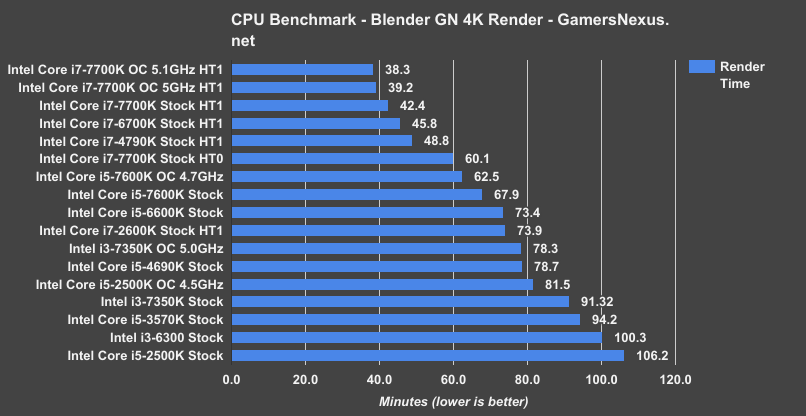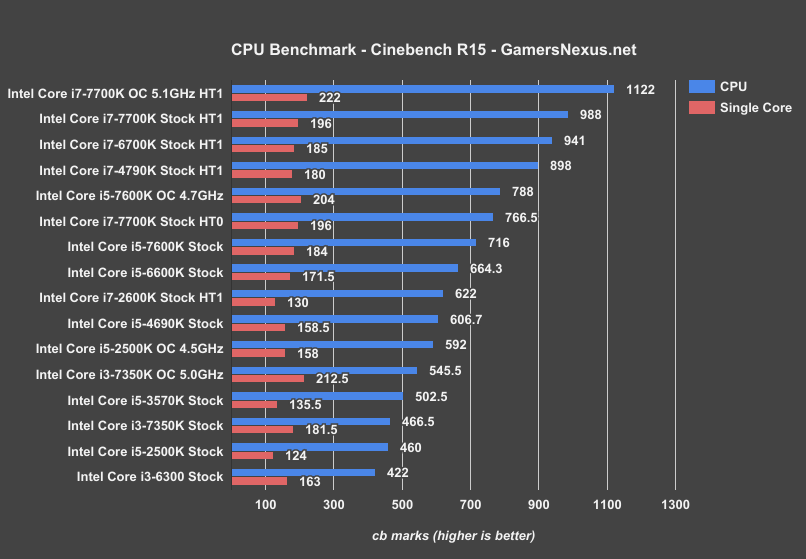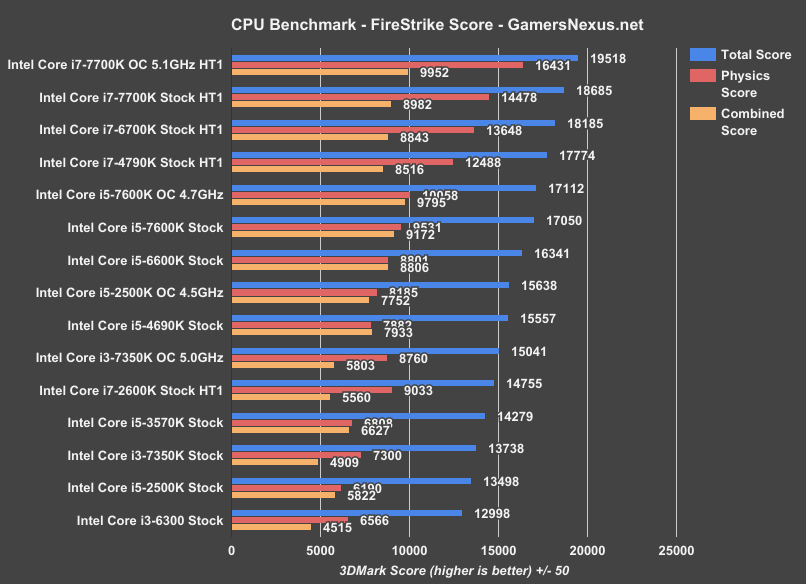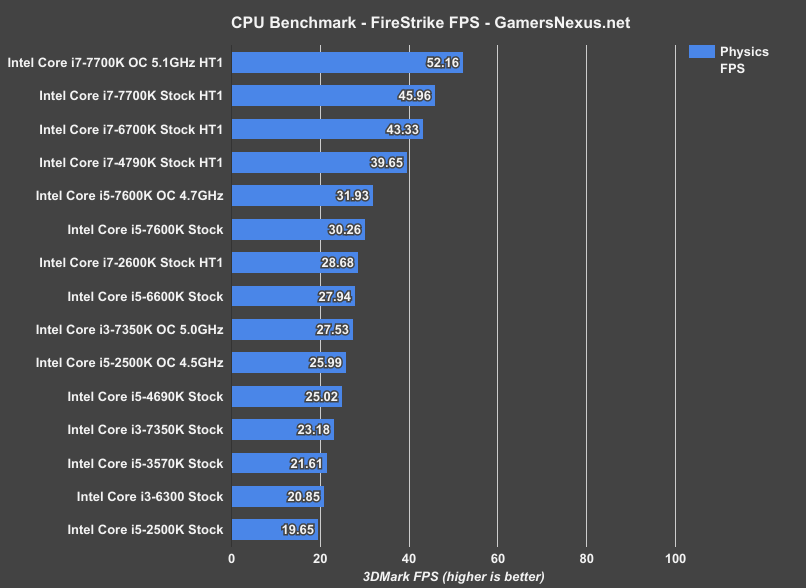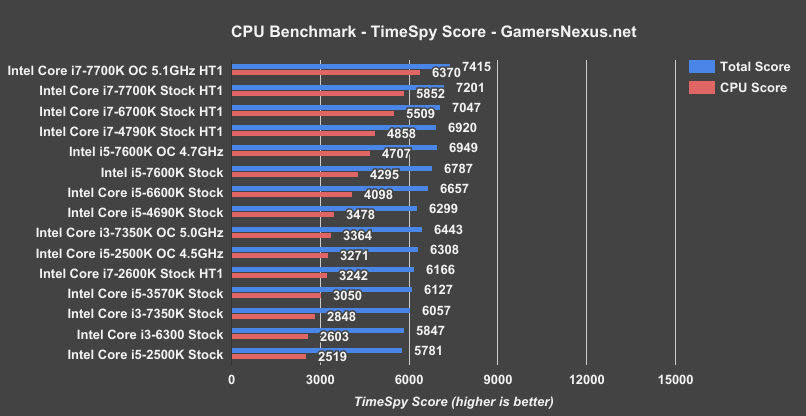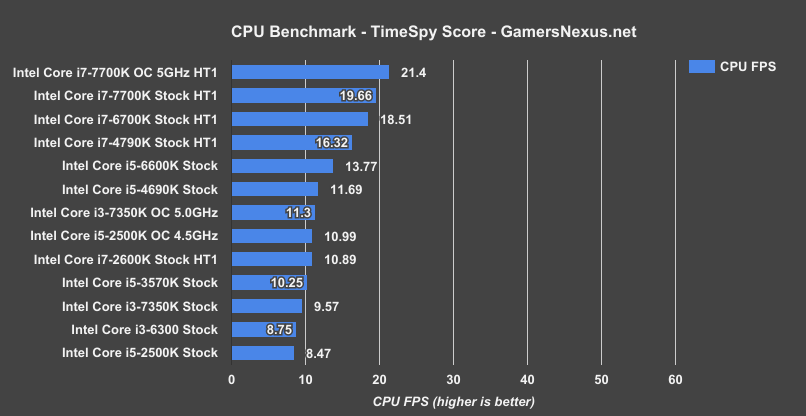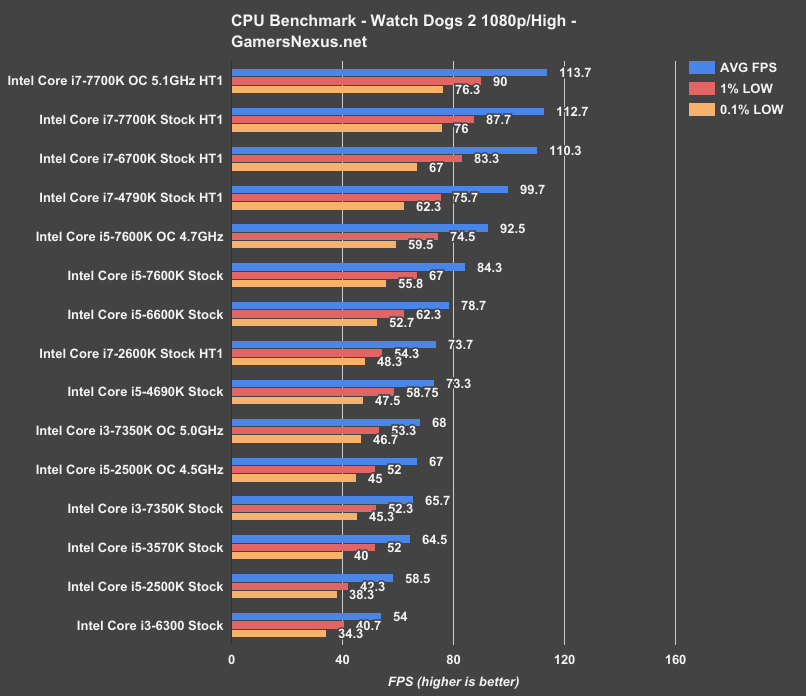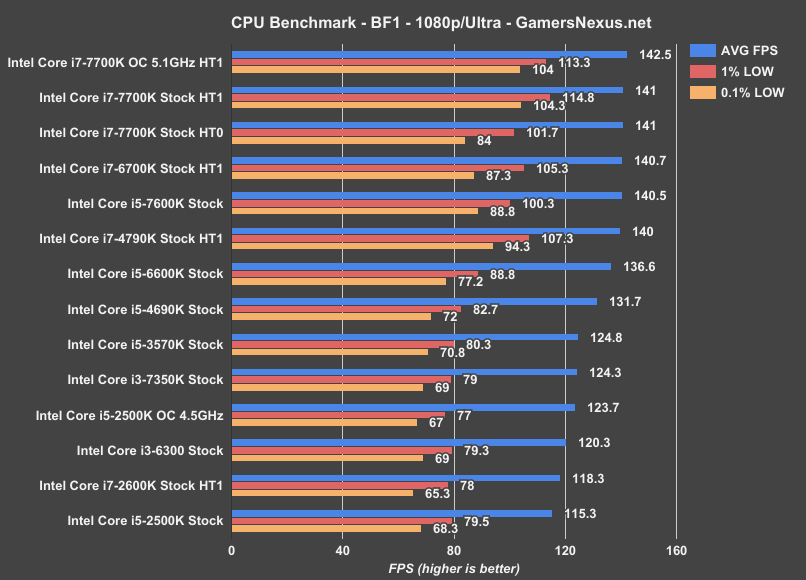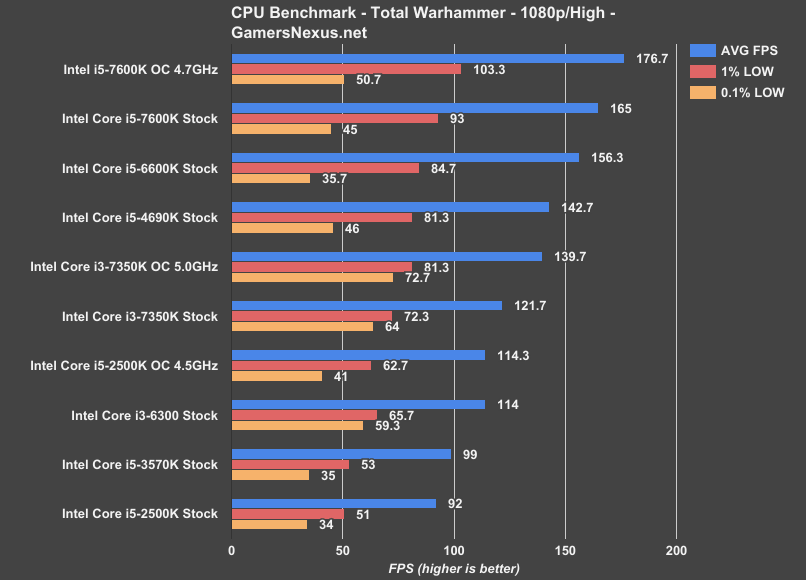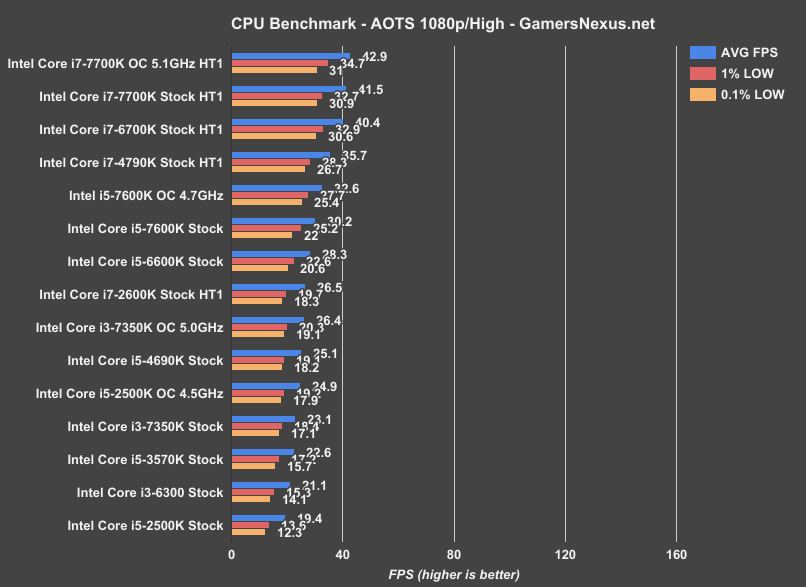The first unlocked i3 CPU, upon its pre-release disclosure to GN, sounded like one of Intel’s most interesting moves for the Kaby Lake generation. Expanding overclocking down to a low/mid-tier SKU could eat away at low-end i5 CPUs, if done properly, and might mark a reprisal of the G3258’s brief era of adoration. The G3258 didn’t hold for long, but its overclocking prowess made the CPU an easy $60-$70 bargain pickup with a small window of high-performance gaming; granted, it did have issues in more multi-threaded games. The idea with the G3258 was to purchase the chip with a Z-series platform, then upgrade a year later with something higher-end.
The i3-7350K doesn’t quite lend itself to that same mindset, seeing as it’s ~$180 and leaves little room between neighboring i5 CPUs. This is something that you buy more permanently than those burner Pentium chips. The i3-7350K is also something that should absolutely only be purchased under the pretense of overclocking; this is not something that should be bought “just in case.” Do or do not – if you’re not overclocking, do not bother to consider a purchase. It’s not uncommon for non-overclockers to purchase K-SKU Core i7 CPUs, generally for desire of “having the best,” but the 7350K isn’t good enough on its own to purchase for that same reason. Without overclocking, it’s immediately a waste.
The question is whether overclocking makes the Intel i3-7350K worthwhile, and that’s what we’ll be exploring in this review’s set of benchmarks. We test Blender rendering, gaming FPS, thermals, and synthetics in today’s review.
For comparison, neighboring non-K Intel products would include the Intel i5-7500 (3.4GHz) for $205, the i3-7100 for $120, and Intel i3-7320 (4.1GHz) for $165. These sandwich the 7350K into a brutal price category, but overclocking might save the chip – we’ll find out shortly.
To catch everyone up, we’ve also already reviewed the Intel i7-7700K ($350) and Intel i5-7600K ($240), both of which can be found below:
In the i7-7700K review, linked above, we already went through Intel’s updated Kaby Lake architecture and its host 14nm+ process. That has not changed with the i3-7350K, and as such, we won’t be going back over that today. The very basics are that Intel’s 14nm+ process refinement has granted an additional couple hundred megahertz of clock headroom, responsible for most of the performance gains we’re seeing this generation.
Here are the specs for all K-SKU products of this generation:
Intel Core i7-7700K vs. i5-7600K, i3-7350K Specs
| Intel Kaby Lake K-SKU CPUs | |||
| GamersNexus.net | i7-7700K | i5-7600K | i3-7350K |
| Cores | 4C/8T | 4C/4T | 2C/4T |
| Frequency | 4.2/4.5GHz | 3.8/4.2GHz | 4.2GHz |
| Overclocking | Yes | Yes | Yes |
| IGP | HD 630 | HD 630 | HD 630 |
| Dynamic Frequency | 1150MHz | 1150MHz | 1150MHz |
| DDR4/DDR3L MHz | 2400/1600 | 2400/1600 | 2400/1600 |
| Intel Smart Cache | 8M | 6M | 4M |
| Memory Channels | Dual | Dual | Dual |
| TDP | 91W | 91W | 60W |
| Process Technology | 14nm+ | 14nm+ | 14nm+ |
| 1ku Price | $339 | $242 | $168 |
Intel Kaby Lake i3 Non-K Specs
| Intel i3 Kaby Lake Specs | |||||
| GamersNexus.net | i3-7320 | i3-7300 | i3-7100 | i3-7300T | i3-7100T |
| Cores | 2C/4T | 2C/4T | 2C/4T | 2C/4T | 2C/4T |
| Frequency | 4.1GHz | 4.0GHz | 3.9GHz | 3.5GHz | 3.4GHz |
| Overclocking | No | No | No | No | No |
| IGP | HD 630 | HD 630 | HD 630 | HD 630 | HD 630 |
| Dynamic Frequency | 1150MHz | 1150MHz | 1100MHz | 1100MHz | 1100MHz |
| DDR4/DDR3L MHz | 2400/1600 | 2400/1600 | 2400/1600 | 2400/1600 | 2400/1600 |
| Intel Smart Cache | 4M | 4M | 3M | 4M | 3M |
| Memory Channels | Dual | Dual | Dual | Dual | Dual |
| TDP | 51W | 51W | 51W | 35W | 35W |
| Process Technology | 14nm+ | 14nm+ | 14nm+ | 14nm+ | 14nm+ |
| 1ku Price | $149 | $138 | $117 | $138 | $117 |
The Intel i3-7350K operates at 4.2GHz fixed, without Boost functionality, and runs with 4MB of L3 Smart Cache. Comparatively, the 7600K offers 6MB of L3 Cache, with the 7700K offering 8MB.
Test Methodology
With the i7, then i5, and now i3 CPUs mostly benchmarked, we’ll next be moving on to include AMD FX processors. That’ll be in time for Ryzen, as you likely suspected, so keep that in mind. If you’re asking why FX isn’t present here, that’s why – we’re adding it to the next round. Our iterative CPU reviewing means that we try to add one line at a time. This helps us focus efforts and analytics on a single device (or family), and controls content scheduling.
Game Test Methodology
NVIDIA 376.33 drivers were used for benchmarking. Game settings were manually controlled for the DUT. All games were run at presets defined in their respective charts. All other game settings are defined in respective game benchmarks, which we publish separately from GPU and CPU reviews. Our test courses, in the event manual testing is executed, are also uploaded within that content. This allows others to replicate our results by studying our bench courses.
Windows 10-64 build 10586 was used for testing.
Each game was tested for 30 seconds in an identical scenario, then repeated three times for parity.
Some benchmarks disable EIST, Turbo, and other features -- please check each section to learn if that is the case. Otherwise, for game benchmarks, assume stock settings (Turbo enabled). We always disable C-states.
Average FPS, 1% low, and 0.1% low times are measured. We do not measure maximum or minimum FPS results as we consider these numbers to be pure outliers. Instead, we take an average of the lowest 1% of results (1% low) to show real-world, noticeable dips; we then take an average of the lowest 0.1% of results for severe spikes.
Core Components (Unchanging)
- NZXT 1200W Hale90v2
- For DDR4 platforms: Corsair Vengeance LPX 32GB 3200MHz
- For DDR3 platforms: HyperX Savage 32GB 2400MHz
- Intel 730 480GB SSD
- Open Air Test Bench
- Cooler #1 (Air): Be Quiet! Dark Rock 3
- Cooler #2 (Cheap liquid): Asetek 570LC w/ Gentle Typhoon fan
- Cooler #3 (High-end): Kraken X62
Note: fan and pump settings are configured on a per-test basis.
Z270 Platforms:
- Gigabyte Aorus Gaming 7 (primary)
- MSI Gaming Pro Carbon (secondary - for thermal validation)
- i7-7700K (x2) samples from motherboard vendors
Both used for the 7700K.
Z170 Platform:
- MSI Gaming M7
- i7-6700K retail
Z97 Platform:
- Gigabyte Z97X G1 WIFI-BK
- i7-4790K
Z77 Platform:
- MSI GD65 Z77
- i7-2600K
Dx12 games are benchmarked using PresentMon onPresent, with further data analysis from GN-made tools.
Note: We'd like to add the i5, i3, and FX CPUs, but this was enough for now. We'll add those as we expand into coverage of Zen or i5 Kaby Lake products.
Thermal Test Methodology
We strongly believe that our thermal testing methodology is among the best on this side of the tech-media industry. We've validated our testing methodology with thermal chambers and have proven near-perfect accuracy of results.
Conducting thermal tests requires careful measurement of temperatures in the surrounding environment. We control for ambient by constantly measuring temperatures with K-Type thermocouples and infrared readers. We then produce charts using a Delta T(emperature) over Ambient value where notated, otherwise, we'll use the diode and sensor measurements to provide a baseline performance metric. AIDA64, Intel Xtreme Tuning Utility, and HW Monitor (CPU PKG) are all used to monitor thermals. It appears that XTU and HW Monitor match in their measurement of CPU PKG for Kaby Lake.
All open bench fans are configured to their maximum speed and connected straight to the PSU. This ensures minimal variance when testing, as automatically controlled fan speeds will reduce reliability of benchmarking. The CPU fan is set to maximum fan speed, unless otherwise stated.
We use an AMPROBE multi-diode thermocouple reader to log ambient actively. This ambient measurement is used to monitor fluctuations and is subtracted from absolute GPU diode readings to produce a delta value. For these tests, we configured the thermocouple reader's logging interval to 1s, matching the logging interval of AIDA64, HW Monitor, and other tools. Data is calculated using a custom, in-house spreadsheet and software solution.
Continue to Page 2 for thermals, Blender, & synthetics.
Intel i3-7350K Temperatures vs. i5-7600K, i7-7700K
For thermals, we’re seeing the i3-7350K operate at around 65C when under the same AVX intensive workload as the 7700K and 7600K shown in the below table. The 7350K has a power draw closer to 60W when under load, and we’re operating at the same 1.275 fixed voltage as in other tests. It’s not necessary to use the Kraken X62 at max RPMs that we’re using to cool this CPU; you’d be able to keep the 7350K under control with a wide variety of simple air coolers, making this chip easier to work with than its hotter counterparts.
As a reminder, auto vCore on some motherboards can drastically increase temperatures, and does so beyond actual usefulness for stability. Gigabyte recently resolved their issues pertaining to high auto vCore, as we reported, but we still recommend venturing into BIOS and manually tuning vCore if it seems high.
| Intel i7-7700K, i5-7600K, i3-7350K EIST 0, Turbo 0, CStates 0 | ||||
| MSI Pro Carbon 7350K | MSI Pro Carbon 7600K | MSI Pro Carbon 7700K | Gigabyte G7 7700K | |
| vCore (v) | 1.28v (manual) | 1.28v (manual) | 1.28-1.32 (auto) | 1.188-1.275 (manual) |
| CPU PKG (C) | 65 | 74 | 82 | 70 |
| Core 0 (C) | 66 | 71 | 82 | 70 |
| Core 1 (C) | 66 | 71 | 79 | 69 |
| Core 2 (C) | 68 | 74 | 78 | 70 |
| Core 3 (C) | 68 | 68 | 76 | 68 |
| Ambient (C) | 25 | 25 | 21 | 22.2 |
| Liquid TMP (C) | 33 | 33 | 28 | 28 |
| PKG PWER (W) | 54-57 Max ~57.7 | 97-100 Max 100.67 | 101-104 Max 111.28 | 101 Max 115.15 |
Intel i3-7350K Blender Rendering Benchmark
Starting off with Blender and the custom render benchmark we made, where we’re rendering various monkey heads with different effects applied, we’re seeing the i3-7350K at 4.2GHz stock complete the scene render in about 91 minutes. This is slower than the overclocked 2500K and faster than the i5-3570K stock. Compared to the previous generation i3, we’re seeing an improvement of about 9 minutes, or roughly a 9% reduction in total render time required. For comparison, the i5-7600K lands us at around 68 minutes pre-overclock, with the 7700K chart-topping at 42 minutes pre-OC.
Overclocking the i3-7350K won’t get us to the top of the chart, but our 5.0GHz overclock gets us to 78.3 minutes required. That’s a reduction of about 16-17% in total render time from the stock version, at which point we’re now running into severe thread limitations. This also lands us ahead of the i5-4690K stock CPU, and just under the stock i7-2600K. Once overclocked, this new i3 K-SKU is on-par with a five generation-old i7 CPU. Not bad.
Intel i3-7350K Cinebench vs. i3-6300, i5-7600K
To throw some standardized synthetics in here, Cinebench posts the 7350K just below the i5-3570K stock CPU, scoring 466.5 cb marks, though the i3 has stronger single-core performance thanks to the boosted frequency. The i3-6300 last-gen CPU that we had on-hand is awarded 422 cb marks, or 163 cb marks for single-threaded performance.
After overclocking the new i3-7350K Kaby Lake CPU to 5.0GHz with a 1.35 vCore, we land just below the overclocked i5-2500K at 4.5GHz for multi-core performance. We’re well ahead in single-core performance, granted, and overall land just below the i5-4690K stock. – though well ahead in single-core performance – and also below the i5-4690K stock CPU.
3DMark Firestrike – i3-7350K vs. i3-6300, 7600K
Running 3DMark Firestrike on ‘Normal,’ we’re seeing the i3-7350K performing about on-par with an i5-4690K in physics processing, though total scores place us closer to the 2500K & 3570K. With overclocking, the i3-7350K is able to produce about the same performance as an i7-2600K with hyperthreading enabled (stock frequency), providing yet another data point indicating comparable performance to a 5 generation-old i7 CPU.
Here’s the FPS chart:
3DMark TimeSpy – i3-7350K vs. i7-2600K, i3-6300K, etc.
More of the same here: The i3-7350K sits near the i5-3570K, and just ahead of the i3-6300. The i5-2500K struggles a bit with TimeSpy, and the i7-2600K (both Sandy Bridge) is just ahead of the i3-7350K. Once overclocked, the 7350K lands just under the stock i5-4690K.
Continue to the next page for gaming benchmarks & the conclusion.
Watch Dogs 2 CPU Benchmark – i3-7350K, i3-6300, i5-7600K, 7700K
Watch Dogs 2 is one of the most thread-intensive modern games we’ve yet looked at, showing significant performance benefit with the hyperthreaded i7 CPUs over even higher-clocked i5 CPUs.
The i3, then, should comparatively struggle with this game. And it sort of does, with the i3-7350K stock CPU (and EVGA GTX 1080 FTW) operating at about 66FPS AVG, comparable to the performance of the Ivy Bridge i5-3570K quad-core from a few years ago. Looking elsewhere on the bench, we see the 7350K operates at around 20FPS slower than the stock i5-7600K, or a percentage reduction of almost 30%, and is nearly 2x slower than the i7-7700K. For this particular game, most GTX 1060 and RX 480 GPU purchases and up would bottlenecked by an i3-7350K. Learn more in our Watch Dogs 2 CPU optimization guide, if that’s an issue.
Overclocking the CPU gets us an extra couple FPS, but we’re more thread-limited in this game than clock-limited, so there’s only so much we can do.
Still, we’re at least seeing a marked 10FPS improvement over the i3-6300.
Battlefield 1 CPU Benchmark – i3-7350K vs. i3-6300, i5-7600K, i5-6600K, 4690K
Battlefield 1 places the i3-7350K CPU at around 124FPS AVG, with lows tightly timed in the 70-80FPS range. Even the i3-6300 can keep up well, with lows in the same range. Although both CPUs are technically bottlenecking a GTX 1080, they’re not really posing a significant bottleneck threat to more realistic video cards for the platform.
The i3-7350K ends up right around where an i5-3570K from a few generations ago performed, and not far below an i5-4690K from the more modern era of Intel CPUs.
Total War: Warhammer CPU Benchmark (Dx11) – i3-7350K vs. i3-6300, 6600K
Again a reminder on Total War: This game has a bit more variance than we’re used to in the low frametime metrics, so those numbers aren’t our driving factor for these benchmarks. Moving to Total War: Warhammer, the i3-7350K stock posts only marginal improvements over the i3-6300 stock, with the former scoring around 122FPS AVG with 72FPS and 64FPS lows, while the latter lands at 114FPS AVG with 66FPS and 59FPS lows. Using the i3-7350K as it should be used – that is, overclocking it to 5.0GHz – we see a significant performance gain up to 140FPS AVG, with lows now in the 70-80 FPS range. That’s a gain of about 15% from an overclock – not bad, and puts us nearly at the performance of an i5-4690K stock.
Ashes of the Singularity CPU Benchmark (Dx12) – i3-7350K
The Ashes CPU-bound benchmark on High is abusive and more meant to give us a hierarchy than useful FPS metrics, since we’re more-or-less ignoring the existence of the GPU.
The i3-7350K stock CPU lands just below the 4.5GHz overclocked i5-2500K on the chart, and just above the i5-3570K stock CPU. Overclocking the i3-7350K gets us up to about on-par performance with the i7-2600K hyperthreaded CPU, and just below the i5-6600K – again, not bad hierarchical placing for an i3 CPU.
Conclusion: Is the i3-7350K Worth It vs. i5?
We were only able to ever stabilize an overclock at 5.0GHz with a 1.35 vCore, and couldn’t seem to push higher without finer tuning. Still, a 5.0GHz Core i3 is nothing to laugh at, and performance overall shows reasonable scaling post-overclock. That said, this is a CPU you should only purchase if you are honestly going to overclock it. Don’t treat this like a K-SKU i7 and buy it in case you “might” want to overclock one day, because you’re just going to rip yourself off in a big way. Overclock it or skip it.
As for value, $180 is a huge asking price. A non-K i5-7500 costs $204, and other i3 CPUs are around $120-$165. This i3-7350K feels like it should probably be a $165 CPU, which is the ~1ku price. Not as exciting as the $60-$80 G3258 of yore, but a step in the right direction. Intel must take this processor and iterate on the idea – namely by lowering price or expanding on OC options to lower SKUs in the future – and they’ll finally get that reinvigorated kick they’ve been needing.
Editorial: Steve Burke
Testing: Patrick Lathan
Video: Andrew Coleman
